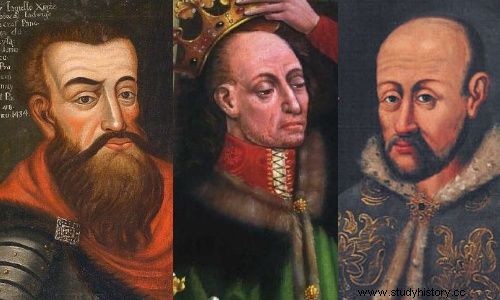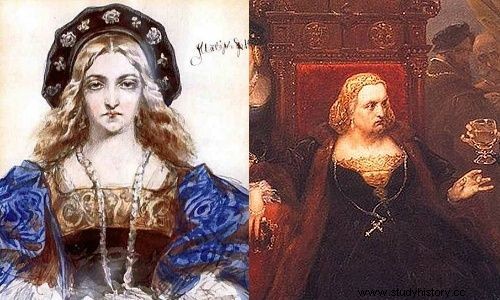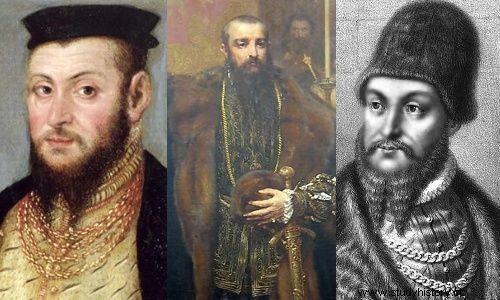Being a king is a tedious job! You have to be dignified, wise and fair. Besides, there is so much to do with wars, foreign legations, and in addition, the queen also bothers. In addition, balls, coronations and other ceremonies where you need to look perfect. After all, the brightest majesty cannot walk in torn gaiters!
One of the most important items in the royal accounts that have survived to this day was expenditure on clothing and fabrics. From these lists we learn what such rulers liked to assume, what materials and colors they preferred. It turns out that members of the Jagiellonian dynasty can be divided into several fashion types.
Monochrome elegance without too much profligacy?
This is probably how the style of the (supposedly) wild Lithuanian, who sat on the throne of Poland in 1386, should be defined. Archives testify that Jagiełło did not wear bearskin tied with a thong. Overall, in terms of clothing, he was far from being a savage. From the holidays, the king wore costumes in the French, Italian, but also Ruthenian and Lithuanian fashion. They were always made of expensive materials (the best quality cloth, silk, velvet and satin), most often in gray and black, rarely white.

Several portraits of Jagiełło. As you can see, his outfit was imagined very differently, but none of the images accurately reflect what the preserved archives say.
Every day, Jagiełło dressed in long and short tunics, sewn from materials dyed gray or black. Similarly in winter, but the clothes intended for this time of year were lined with fur, e.g. from the bellies of dormice or marten. The rulers also sewed two costumes for horse riding and hunting, consisting of a short caftan and a coat, all in shades of gray, and a set of clothes made of black cloth.
In addition to outerwear, royal accessories were an indispensable element of clothing. First, headgear. Most often, Jagiełło wore a gray or black beret, and in the summer he wore a taffeta-lined straw hat. The royal accounts also include mittens, or fur hats. After all, it is not fitting for a crowned head wrapped in a warm coat (coat lined with fur) to freeze in the ears.
Two types of gloves were made for the king - for summer and for winter. Those intended for cold days were lined with fur. In the summer, His Majesty wore silk gloves. The silk itself did not seem expensive and dignified, so it was additionally embroidered with pearls. On top of all this, there were also shoes. After all, the majesty does not walk barefoot! Jagiełło wore several types of footwear:boots with elongated toes, colored leather boots with buckles, cloth-insulated boots with uppers and ... sandals.
Until the eye turns white. Italian necklines at the Polish court
Fashion at the Jagiellonian court at the turn of the 15th and 16th centuries was rather modest. Everything turned upside down with the arrival of an Italian princess ... Bona Sforza came to Poland in 1518 and started a real revolution. Until now, Polish ladies wore a delicate T-shirt under every dress other than Spanish. This inconspicuous underwear was embroidered with beautiful patterns and decorated with pearls or other jewels at the collar. More and more ladies were starting to get used to Spanish. It meant subdued colors and dresses right up to the neck, finished with a ruff. Against this background, the arrival of Bona and her Italian maids must have caused a genuine shock.

Queen Bona was not ashamed of her cleavage. Neither in youth nor in old age…
The Italian fashion was definitely bolder. Not only did she not shyly cover everything below the jawline, but she even allowed herself the bold cleavage that can be seen in the portraits of Italian women from that period. Well ... this "indecent" trend caught on, and male courtiers began to be distracted not only by the singing of the troubadours .
The future spouse of King Sigismund brought from Italy a beautiful trip that took the breath of Polish courtiers, who were not used to such luxuries. Although no list of items brought by Bona has survived in the archives, various sources provide us with detailed descriptions of her clothes. It is known that one of the most numerous elements of Sforza's expedition was bed linen. As Urszula Borkowska lists in the book "The Jagiellonian Dynasty in Poland", she brought a total of 115 shirts, including 12 nightgowns, 120 handkerchiefs, all embroidered with colored silk.
A quite separate matter is the queen's dresses. About twenty dresses made of brocade, velvet and goldhead dripping with splendor came from Italy with her. The best Italic masters decorated them with golden plaques, jewels and heavy, intricate embroidery. The dresses are matched with a dozen beautiful, embroidered and decorated with precious jewels hats. Although all Bona's dresses made a sensation, the one in which the queen was married made the greatest impression on the courtiers. It was made of blue satin, with a symbolic message embroidered with golden threads. Well, this outfit is decorated with images of hives, signifying diligence. As it turned out, Bona Sforza later accumulated property in Poland as meticulously as honey bees ...
King of the tuner, or maybe a modern fashionista?
From today's perspective, many would call Zygmunt August a metrosexual man. However, if we asked the opinion of the king's contemporaries, they would answer without hesitation:nonsense! After all, it is a royal duty to look dignified and rich. But Zygmunt August was probably an extreme exaggeration.
First, it was extremely wasteful. More than one Renaissance European monarch could envy him his wardrobes. The king did not regret it:he wore Hungarian, Italian, Spanish and German costumes made of gold-head, velvet, the finest cloth, all lined with sables, lynxes and black foxes. Glamor with a full mouth.

Zygmunt August did not spare purses for clothes. Unfortunately, his clothing tastes are not fully reflected in the portraits of the ruler ...
The royal clothes were kept by the chamberlains. They were all recorded in special registers, one of which was entitled:"The robes of the King of His Majesty, Italian and German, lined and unstitched, while each garment is described with a cabat, clothing, colet, sword, dagger, belt, purse, biretta, ferets and pontoons. ". It is clear from the title itself that the royal clothes and items were arranged in matching sets. It can therefore be assumed that Zygmunt August, with such an orderly wardrobe, did not experience any "fashion mishaps".
According to popular opinion at that time, in his youth, Sigismund Augustus wore colorful, joyful costumes. He was to abandon them forever when his beloved Barbara left this world. Well, this cliche can be put into fairy tales. It is true that the king ordered to buy a lot of black cloth, with which his chambers were upholstered and upholstered, when he was transporting his wife's corpse to Lithuania, he ordered black clothes for courtiers and servants, and he also offered black matter in the churches that he passed, but, as his bills show, he preferred this color before he met Radziwiłłówna. From his youth, Zygmunt August spent over 90% of his money on black or gray clothes . An additional advantage of these two colors was the fact that they looked very flattering in combination with golden chains and other gems that Jagiellon simply adored.
To make everything work together, the king began to dress his courtiers and guards in the same clothes. Most often they were sewn from fabrics in… black color. Even the jesters didn't get away with it. The red outfit, which we associate with Stańczyk from Matejko's painting, was of course replaced with a black one , sewn in Vilnius.
Zygmunt August was inspired by the fashion of practically all of Europe. The tailors sewed Italian, Hungarian, German and Spanish costumes for him, and papal legates and envoys admired the richness of patterns. The king also had a lot of small accessories, such as pouches, gloves, berets, hats, mittens and fur caps, all of the best materials. One could exchange endlessly, after all, bed linen, jewels, military garments ...
Source:
- Urszula Borkowska, The Jagiellonian Dynasty in Poland , Polish Scientific Publishers PWN, Warsaw 2011.
